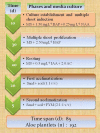Propagation Techniques and Agronomic Requirements for the Cultivation of Barbados Aloe (Aloe vera (L.) Burm. F.)-A Review
- PMID: 27721816
- PMCID: PMC5033982
- DOI: 10.3389/fpls.2016.01410
Propagation Techniques and Agronomic Requirements for the Cultivation of Barbados Aloe (Aloe vera (L.) Burm. F.)-A Review
Abstract
Barbados aloe (Aloe vera (L.) Burm. F.) has traditionally been used for healing in natural medicine. However, aloe is now attracting great interest in the global market due to its bioactive chemicals which are extracted from the leaves and used in industrial preparations for pharmaceutical, cosmetic, and food products. Aloe originated from tropical and sub-tropical Africa, but it is also now cultivated in warm climatic areas of Asia, Europe, and America. In this review, the most important factors affecting aloe production are described. We focus on propagation techniques, sustainable agronomic practices and efficient post harvesting and processing systems.
Keywords: abiotic stress tolerance; burn plant; crop husbandry; in vitro propagation protocols; leaf processing; leaf yield.
Figures






Similar articles
-
Acute and sub-chronic toxicity studies of three plants used in Cameroonian ethnoveterinary medicine: Aloe vera (L.) Burm. f. (Xanthorrhoeaceae) leaves, Carica papaya L. (Caricaceae) seeds or leaves, and Mimosa pudica L. (Fabaceae) leaves in Kabir chicks.J Ethnopharmacol. 2016 Feb 3;178:40-9. doi: 10.1016/j.jep.2015.11.049. Epub 2015 Dec 2. J Ethnopharmacol. 2016. PMID: 26657577
-
Quantitative determination of aloin, antioxidant activity, and toxicity of Aloe vera leaf gel products from Greece.J Sci Food Agric. 2021 Jan 30;101(2):414-423. doi: 10.1002/jsfa.10650. Epub 2020 Aug 13. J Sci Food Agric. 2021. PMID: 32643805
-
First Report of Alternaria alternata Causing Leaf Spot on Aloe vera in Louisiana.Plant Dis. 2012 Sep;96(9):1379. doi: 10.1094/PDIS-04-12-0343-PDN. Plant Dis. 2012. PMID: 30727184
-
Final report on the safety assessment of AloeAndongensis Extract, Aloe Andongensis Leaf Juice,aloe Arborescens Leaf Extract, Aloe Arborescens Leaf Juice, Aloe Arborescens Leaf Protoplasts, Aloe Barbadensis Flower Extract, Aloe Barbadensis Leaf, Aloe Barbadensis Leaf Extract, Aloe Barbadensis Leaf Juice,aloe Barbadensis Leaf Polysaccharides, Aloe Barbadensis Leaf Water, Aloe Ferox Leaf Extract, Aloe Ferox Leaf Juice, and Aloe Ferox Leaf Juice Extract.Int J Toxicol. 2007;26 Suppl 2:1-50. doi: 10.1080/10915810701351186. Int J Toxicol. 2007. PMID: 17613130 Review.
-
Aloe vera (L.) Webb.: Natural Sources of Antioxidants - A Review.Plant Foods Hum Nutr. 2019 Sep;74(3):255-265. doi: 10.1007/s11130-019-00747-5. Plant Foods Hum Nutr. 2019. PMID: 31209704 Free PMC article. Review.
Cited by
-
Dataset on the influence of zinc foliar application and vermicompost on agromorphogenic traits of Aloe vera.Data Brief. 2021 Sep 30;38:107436. doi: 10.1016/j.dib.2021.107436. eCollection 2021 Oct. Data Brief. 2021. PMID: 34646919 Free PMC article.
-
Agrivoltaic systems for sustainable energy and agriculture integration in Turkey.Heliyon. 2024 Jun 1;10(11):e32300. doi: 10.1016/j.heliyon.2024.e32300. eCollection 2024 Jun 15. Heliyon. 2024. PMID: 38912471 Free PMC article.
-
Molecular mechanisms and associated cell signalling pathways underlying the anticancer properties of phytochemical compounds from Aloe species (Review).Exp Ther Med. 2021 Aug;22(2):852. doi: 10.3892/etm.2021.10284. Epub 2021 Jun 8. Exp Ther Med. 2021. PMID: 34178125 Free PMC article. Review.
-
Production of Aloe vera Phytoplacenta Extract and Potential Applications in Skincare.Life (Basel). 2025 Mar 3;15(3):397. doi: 10.3390/life15030397. Life (Basel). 2025. PMID: 40141742 Free PMC article.
-
Efficient Micropropagation of Sedum sediforme and S. album for Large-Scale Propagation and Integration into Green Roof Systems.Plants (Basel). 2025 Jun 13;14(12):1819. doi: 10.3390/plants14121819. Plants (Basel). 2025. PMID: 40573807 Free PMC article.
References
-
- Abadi D. H., Kaviani B. (2010). In vitro proliferation of an important medicinal plant Aloe -A method for rapid production. Aust. J. Crop Sci. 4, 216–222.
-
- Abdi G., Hedayat M., Modarresi M. (2013). In vitro micropropagation of Aloe vera - Impacts of plant growth regulators, media and type of explants. J. Biol. Environ. Sci. 7, 19–24.
-
- Abrie A. L., Van Staden J. (2001). Micropropagation of the endangered Aloe polyphylla. Plant Growth Regul. 33, 19–23. 10.1023/A:1010725901900 - DOI
-
- Adelberg J., Fári M. G. (2010). Applied physiology and practical bioreactors for plant propagation. Propag. Ornam. Plants. 10, 205–219.
-
- Adelberg J., Naylor-Adelberg J. (2012). Effects of cytokinin on multiplication and rooting of Aloe barbadensis during micropropagation on agar and liquid medium. J. Med. Active Plants. 1, 1–5. 10.7275/R5HH6H0V - DOI
Publication types
LinkOut - more resources
Full Text Sources
Other Literature Sources
Molecular Biology Databases

